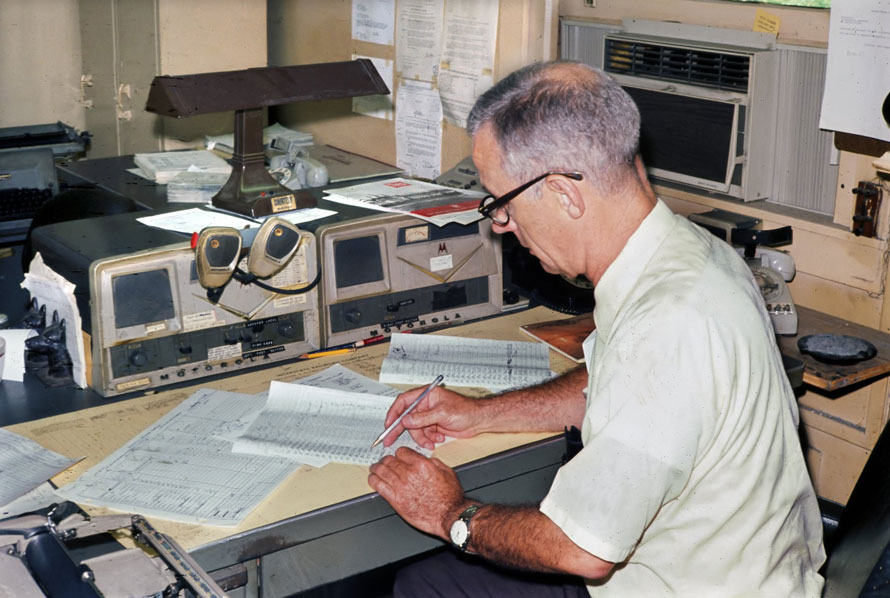
This old shot, taken on September 11, 1968 at Andover, Virginia, is a real classic in terms of “content.” This is Mr. Ed Renfro. He was the swing-shift Interstate Railroad dispatcher (meaning he covered the off days for the regular first, second and third trick dispatchers so his sleep cycle was always screwed up!) Ed lived in Norton, and also filled the job as first trick car distributor at times. I was doing my janitorial chores at Andover that particular evening and thought he would make a great photo subject. Indeed he did!
Check out those old Motorola radios. The mics were activated by a old-fashioned foot pedal beneath the desk. One transmitted from Andover, but the second one had a tower on High Knob, above Norton. I found out later that radio on the “Knob” could be heard in Louisville and Spartanburg! I could sometimes hear the dispatcher in Louisville issue orders for a meet at “Coal Chute” (just west of Lawrenceburg, Kentucky), or the yard master in Hayne Tower (Spartanburg, South Carolina) complaining about “that dispatcher in Andover blasting us off the air!”
Computer, you ask? Dude – this was 1968!
On the desk is the dispatcher train sheet for that day, and the forms Ed has before him are the daily car distributions. All mines had a rating based on production and need, so empties were distributed on that basis, particularly when car supply was tight. The two typewriters shown are both manual, and the phone is a rotary dial. The receiver has a head-rest so you could prop it on your shoulder to free up your hands to take notes.
Computer, you ask? Dude – this was 1968! The only computers were big main frame models with tape drives in big air conditioned rooms in the Spring Street offices of Southern in Atlanta, Georgia.
The Interstate was a busy little coal-hauling short line, and had merged into the Southern in 1961. Still, it was given quite a bit of operational autonomy. There were normally seven regular train crews, plus one or two extras as needed, so the railroad was always busy, particularly during weekdays. There were no scheduled trains, but operations were conducted by traditional train orders, issued by the dispatcher by radio to train conductors and engineers. MofW equipment (track equipment, motor cars, etc.) were treated as trains as well, and were issued orders, including arranged meeting points with trains.
Today, Andover Yard is a virtual ghost facility. The Interstate dispatcher signed off at the end of October 1985, long after Ed had retired. Never take today’s commonplace for granted. Take a photo, and remember the details of the day. It’s history in the making.
Ron Flanary – Photograph and text Copyright 2020
“MofW equipment (track equipment, motor cars, etc.) were treated as trains” a good safety move which was not duplicated on larger RR’s probably because of lack of adequate information/communication (due to the demise of manned stations) and low MofW status. An exception could occur if MofW moves conflicted with trackage rights moves.
I was able to be a part of train operation on the former Interstate Railroad (IRR) during the strike that occurred on Southern Railway (SR) in the same year that Pope John Paul I was elected and died (a day or two after the strike ended. The operative word in Andover Yard was “tie a hand brake”, and the operation of trains was done so that you had lots of time to watch the scenery as you passed it. I have date nails from Norton Wye, having been delayed there for some forgotten reason.
My favorite phrase from that area was: From Wentz it came. Wentz was a station on the opposite end of the IRR Main that extended beyond the Zero Milepost, into what might be called negative mileposts. It was probably not deemed long enough to have branch line mileposting and unimportant enough to be ignored.
It is interesting to note what is missing. There is no board large or small with which to control train movements by signal indications. I doubt if the Interstate had signals that they controlled; the larger connecting RR companies may have had signals that affected the IRR. I’ll also mention the ashtray that probably would have had to have disappeared when in office smoking was outlawed on SR probably about the same time the office was closed.
Great article.
Ron great story! My dad was a towermen, then train dispatcher and I worked on the railroad and met many. Your advice on taking pictures is so true. today many do but back in the old days not so much I wish I had taken more myself.
Good stuff… great narrative. Thanks.